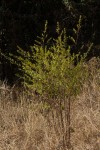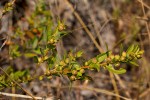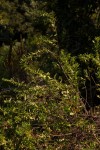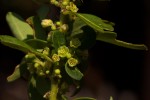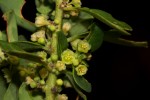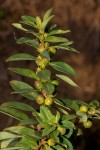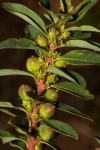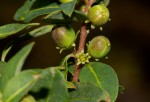Clutia paxii
Selected images: Click on each image to see a larger version and details of the record View all images (13)
Detailed records: Display species records QDS maps by: Google Maps Point records by Google Maps
Species details: Click on each item to see an explanation of that item (Note: opens a new window)
| Synonyms: |
Clutia phyllanthoides S. Moore Cluytia gracilis Hutch. Cluytia stenophylla Pax & K. Hoffm. |
| Common names: | |
| Frequency: | |
| Status: | Native |
| Description: |
Virgate small shrub up to 2.5 m tall. Leaves obovate to elliptic-lanceolate, mostly up to c. 3 × 1.5 cm, green above, greyish-green beneath, hairless or sparingly pubescent on both surfaces, turning bright red when older; lateral veins often very indistinct; petiole 0.5-3 mm. Flowers unisexual on different plants. Male flowers in many-flowered clusters, greenish-white to yellowish, with 2-3 glands at the base of the petals. Female flowers solitary or in pairs, greenish-yellow. Fruit c. 4 × 4 mm, hairless, green to dull reddish-brown. |
| Type location: |
Tanzania |
| Notes: | |
| Derivation of specific name: | paxii: possibly for Ferdinand Albin Pax (1858-1942), German botanist and entomologist, professor of botany and zoology at the Technical University of Wroclaw and Director of the Botanical Garden at Breslau. |
| Habitat: | In ericoid scrub and on the margins of submontane forest. |
| Altitude range: (metres) | 1525 - 2400 m |
| Flowering time: | |
| Worldwide distribution: | DRC (Kivu), Rwanda, Burundi, Tanzania, Malawi, Mozambique, Zambia and Zimbabwe. |
| FZ divisions: | N |
| Growth form(s): | |
| Endemic status: | |
| Red data list status: | |
| Insects associated with this species: | |
| Spot characters: | Display spot characters for this species |
| Images last updated: | Thursday 30 August 2018 |
| Literature: |
Burrows, J.E. & Willis, C.K. (eds) (2005). Plants of the Nyika Plateau Southern African Botanical Diversity Network Report No. 31 SABONET, Pretoria Page 144. Burrows, J.E., Burrows, S.M., Lötter, M.C. & Schmidt, E. (2018). Trees and Shrubs Mozambique Publishing Print Matters (Pty), Cape Town. Page 435. (Includes a picture). Chapano, C. & Mamuto, M. (2003). Plants of the Chimanimani District National Herbarium and Botanic Garden, Zimbabwe Page 14. Coates Palgrave, K. (revised and updated by Meg Coates Palgrave) (2002). Trees of Southern Africa 3rd edition. Struik, South Africa Page 513. Da Silva, M.C., Izidine, S. & Amude, A.B. (2004). A preliminary checklist of the vascular plants of Mozambique. Southern African Botanical Diversity Network Report No. 30 Sabonet, Pretoria Page 55. Drummond, R.B. (1975). A list of trees, shrubs and woody climbers indigenous or naturalised in Rhodesia. Kirkia 10(1) Page 252. Fischer, E. & Killmann, D. (2008). Illustrated Field guide to the Plants of Nyungwe National Park Rwanda. University of Koblenz-Landau. Page 256. (Includes a picture). Mapaura, A. & Timberlake, J. (eds) (2004). A checklist of Zimbabwean vascular plants Southern African Botanical Diversity Network Report No. 33 Sabonet, Pretoria and Harare Page 41. Ntore, S. & al. (2024). Checklist of the vascular plants of Burundi Page 185. Phiri, P.S.M. (2005). A Checklist of Zambian Vascular Plants Southern African Botanical Diversity Network Report No. 32 Page 48. Radcliffe-Smith, A. (1996). Euphorbiaceae Flora Zambesiaca 9(4) Pages 129 - 139. White, F., Dowsett-Lemaire, F. & Chapman, J.D. (2001). Evergreen forest flora of Malawi Royal Botanic Gardens, Kew Page 247. Wursten, B., Timberlake, J. & Darbyshire, I. (2017). The Chimanimani Mountains: an updated checklist. Kirkia 19(1) Page 97. |
Other sources of information about Clutia paxii:
Our websites:
Flora of Burundi: Clutia paxiiFlora of Mozambique: Clutia paxii
Flora of Rwanda: Clutia paxii
Flora of Zambia: Clutia paxii
Flora of Zimbabwe: Clutia paxii
External websites:
African Plants: A Photo Guide (Senckenberg): Clutia paxiiAfrican Plant Database: Clutia paxii
BHL (Biodiversity Heritage Library): Clutia paxii
EOL (Encyclopedia of Life): Clutia paxii
GBIF (Global Biodiversity Information Facility): Clutia paxii
Google: Web - Images - Scholar
iNaturalist: Clutia paxii
IPNI (International Plant Names Index): Clutia paxii
JSTOR Plant Science: Clutia paxii
Mansfeld World Database of Agricultural and Horticultural Crops: Clutia paxii
Plants of the World Online: Clutia paxii
Tropicos: Clutia paxii
Wikipedia: Clutia paxii
